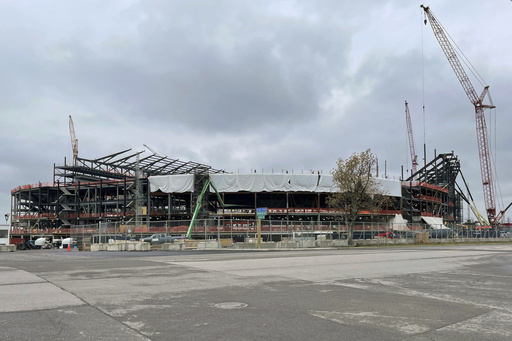
ORCHARD PARK, N.Y. — The anticipated expenses for the construction of the Buffalo Bills’ new stadium have surged, with team representatives revealing that the total is now projected to exceed $2.1 billion. The burden of covering the excess costs, which amount to over $560 million, will fall on the team owners, Terry and Kim Pegula.
Bills president Pete Guelli expressed that while the rising costs are significant, they are not unexpected, given the consistent trends observed since construction began 16 months ago. He emphasized that the Pegulas remain dedicated to maintaining a high standard for the stadium, opting not to compromise on quality in order to cut costs. “In short, the Pegulas are committed to creating a premier stadium experience here in Buffalo,” Guelli remarked.
Guelli praised the vision for the new venue, which he believes will enhance the overall experience for fans and provide a remarkable atmosphere for players. “We are excited to provide an incredible facility for our supporters,” he noted, reinforcing that the success of this project is vital for the organization both on and off the field. He also reassured that the budget increases will not affect the stadium’s completion schedule, with plans for it to open by June 2026, situated directly across from the Bills’ current stadium.
Taxpayers are contributing a total of $850 million towards this initiative, broken down into $600 million from the state and $250 million from the county. Initially, this financial backing represented more than half of the expected costs, but with rising figures, taxpayers’ responsibility has decreased to about 40%. The Bills will be accountable for any expenditures that exceed $1.54 billion.
“Knowing that, at the end of this process, Erie County will likely only have contributed around 12% of the total costs is a significant victory,” Erie County executive Mark Poloncarz noted, reflecting on the project’s financial landscape.
As it stands, the Pegulas are responsible for $1.25 billion of the construction budget, alongside an additional $144 million dedicated to a community benefits program over a 30-year lease period. The Bills plan to finance their portion through an NFL loan program coupled with revenue from a first-ever seat licensing fee for season ticket holders. There are also preliminary plans for an entertainment district featuring dining and shopping experiences, to be developed once the existing stadium is dismantled.
In a separate but related strategy, Pegula is seeking to sell a minority stake—no more than 25%—of the franchise. Guelli clarified that this move is not directly tied to the inflation in construction costs, as discussions with potential investors took place during the summer and are projected to conclude with a new partnership by year’s end.
Since acquiring the franchise for $1.4 billion from the estate of Hall of Fame owner Ralph Wilson in 2014, the Bills have seen their valuation rise to $4.2 billion according to Forbes. The new stadium is designed to accommodate approximately 60,000 fans, which is a reduction from the current stadium’s capacity of around 72,000. The existing facility, opened in 1973, is now outdated and facing structural issues.
The new stadium will not have a roof but will feature a design that includes curved sides aimed at shielding most spectator areas from the harsh winds typical of the nearby Lake Erie. Positioning the venue to face north-south instead of the current east-west orientation is intended to further enhance fan comfort during games.
John Polka, the vice president of stadium development, pointed out that the increase in costs results largely from inflation, which has driven up material prices, along with rising labor expenses and additional design modifications made post-agreement with state and county officials. “We’ve intentionally prioritized quality over cost-cutting. We’ve revisited some aspects of design to enhance fan experiences and competitive advantages,” Polka said, highlighting the commitment of the Pegula family to the integrity of the project.
The state’s Empire State Development agency, responsible for overseeing the new stadium’s operations, stated that the agreement has led to a decrease in the state’s financial contribution to about 29%, while also securing $462 million in contracts for minority and women-owned businesses.
Guelli reflected on the significance of this development for fans, recalling the concerns during his early tenure with the team about the Bills possibly relocating. “The transformation from fears of the Bills leaving to witnessing a $2 billion stadium taking shape across the street is rewarding for everyone involved, especially for the Pegula family,” he remarked, expressing his gratitude for being a part of the project.

